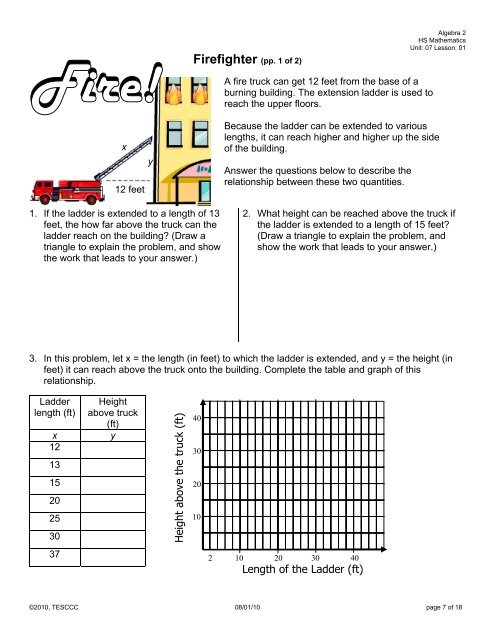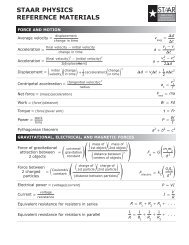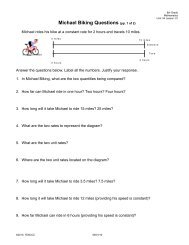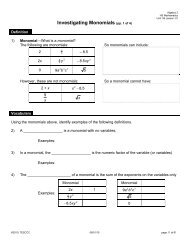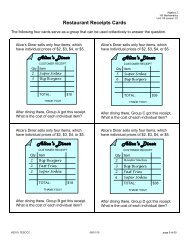Firefighter (pp. 1 of 2)
Firefighter (pp. 1 of 2)
Firefighter (pp. 1 of 2)
Create successful ePaper yourself
Turn your PDF publications into a flip-book with our unique Google optimized e-Paper software.
<strong>Firefighter</strong> (<strong>pp</strong>. 1 <strong>of</strong> 2)<br />
Algebra 2<br />
HS Mathematics<br />
Unit: 07 Lesson: 01<br />
A fire truck can get 12 feet from the base <strong>of</strong> a<br />
burning building. The extension ladder is used to<br />
reach the u<strong>pp</strong>er floors.<br />
x<br />
12 feet<br />
1. If the ladder is extended to a length <strong>of</strong> 13<br />
feet, the how far above the truck can the<br />
ladder reach on the building? (Draw a<br />
triangle to explain the problem, and show<br />
the work that leads to your answer.)<br />
y<br />
Because the ladder can be extended to various<br />
lengths, it can reach higher and higher up the side<br />
<strong>of</strong> the building.<br />
Answer the questions below to describe the<br />
relationship between these two quantities.<br />
2. What height can be reached above the truck if<br />
the ladder is extended to a length <strong>of</strong> 15 feet?<br />
(Draw a triangle to explain the problem, and<br />
show the work that leads to your answer.)<br />
3. In this problem, let x = the length (in feet) to which the ladder is extended, and y = the height (in<br />
feet) it can reach above the truck onto the building. Complete the table and graph <strong>of</strong> this<br />
relationship.<br />
Ladder<br />
length (ft)<br />
x<br />
12<br />
13<br />
15<br />
20<br />
25<br />
30<br />
Height<br />
above truck<br />
(ft)<br />
y<br />
Height above the truck (ft)<br />
40<br />
30<br />
20<br />
10<br />
37<br />
2 10 20 30 40<br />
Length <strong>of</strong> the Ladder (ft)<br />
©2010, TESCCC 08/01/10 page 7 <strong>of</strong> 18
<strong>Firefighter</strong> (<strong>pp</strong>. 2 <strong>of</strong> 2)<br />
Algebra 2<br />
HS Mathematics<br />
Unit: 07 Lesson: 01<br />
A function to model the relationship between the length <strong>of</strong> the ladder (x) and the height it can extend<br />
2<br />
above the truck is f( x) x 144 .<br />
4. Where does this function come from? Or, how is it derived?<br />
5. To see the graph, you may have to change your<br />
calculator’s WINDOW. What WINDOW settings<br />
would match the graph on the preceding page?<br />
Xmin = ____<br />
Xmax = ____<br />
Xscl = ____<br />
Ymin = ____<br />
Ymax = ____<br />
Yscl = ____<br />
6. Type this function into your calculator’s Y = menu. Then go to the TABLE (2 nd , GRAPH). Scroll<br />
through the table until you see entries for X = 5, 6, 7, and 8. Record what you see below.<br />
X Y 1<br />
5<br />
6<br />
7<br />
8<br />
C) Explain what this means in context <strong>of</strong> the problem (with<br />
ladders and buildings).<br />
D) What does this mean in terms <strong>of</strong> the numbers? (In other<br />
words, why does the calculator do this?)<br />
7. What would you say is the domain <strong>of</strong> the function<br />
f x<br />
2<br />
( ) x 144<br />
?<br />
8. What is the range?<br />
9. How do the numerical domain and range relate to the original word problem?<br />
©2010, TESCCC 08/01/10 page 8 <strong>of</strong> 18
Extra Practice: Solving with x 2<br />
Algebra 2<br />
HS Mathematics<br />
Unit: 07 Lesson: 01<br />
Multiple Choice. Read each question carefully. Show your work in the space provided.<br />
1. During a storm, a telephone pole broke<br />
and fell as shown.<br />
2. From her campsite, Wanda hiked 2 miles<br />
due east, then 1.5 miles due south, then<br />
walked directly back to the campsite.<br />
Camp<br />
12 feet<br />
2 miles<br />
16 feet<br />
1.5 miles<br />
What was the original height <strong>of</strong> the pole?<br />
A) 20 feet<br />
B) 28 feet<br />
C) 32 feet<br />
D) 36 feet<br />
Show your work:<br />
What was the total distance that Wanda<br />
hiked?<br />
E) 2.5 miles<br />
F) 3.5 miles<br />
G) 6 miles<br />
H) 6.25 miles<br />
Show your work:<br />
Solve. Solve each equation using the method described.<br />
3. Solve using<br />
square roots.<br />
2<br />
x 56 177<br />
4. Solve using<br />
square roots.<br />
2<br />
8x 35 63<br />
5. Solve by<br />
factoring.<br />
2<br />
x 5x24 0<br />
6. Solve using the<br />
quadratic<br />
formula.<br />
2<br />
2x<br />
9x5 0<br />
©2010, TESCCC 08/01/10 page 10 <strong>of</strong> 18
Squaring and Rooting: Inverses (<strong>pp</strong>. 1 <strong>of</strong> 4)<br />
Algebra 2<br />
HS Mathematics<br />
Unit: 07 Lesson: 01<br />
Warm-Up<br />
Solve each equation for x. Remember: These equations usually have two solutions.<br />
A)<br />
2<br />
x 21 70<br />
B)<br />
2<br />
4x 12 13<br />
C)<br />
2<br />
( x 3) 4 40<br />
1. Review <strong>of</strong> Quadratic Functions<br />
2<br />
A. For the equation y x , complete<br />
the table. Then plot points to<br />
construct the graph.<br />
B. If the domain <strong>of</strong> the equation is {-<br />
3,-2,-1,0,1,2,3}, then what would<br />
be the range?<br />
C. Is this equation a function?<br />
Explain.<br />
x<br />
-3<br />
-2<br />
-1<br />
0<br />
1<br />
2<br />
3<br />
y<br />
x<br />
2<br />
y<br />
-4<br />
-4<br />
4<br />
4<br />
2. Inverse with Coordinates<br />
A. Recall that an inverse can be<br />
formed by switching the x- and y-<br />
coordinates in a relation. Use this<br />
method to make a table and graph<br />
2<br />
for the inverse <strong>of</strong> y x .<br />
B. Is this inverse a function?<br />
Explain.<br />
Inverse<br />
x<br />
y<br />
-3<br />
-2<br />
-1<br />
0<br />
1<br />
2<br />
3<br />
-4<br />
4<br />
4<br />
-4<br />
3. Inverse with Algebra<br />
Remember that another way<br />
to find an inverse is to switch<br />
the x and y variables in an<br />
equation, then solve for the<br />
“new” y.<br />
Equation: y x<br />
Inverse: ____ = ____ 2<br />
Solve:<br />
2<br />
B. Use a calculator to help you sketch<br />
the graph <strong>of</strong> this inverse equation<br />
in the box below.<br />
A. Use this algebraic method<br />
to find the inverse <strong>of</strong><br />
2<br />
y x .<br />
Notation:<br />
f<br />
1 ( x<br />
) <br />
Does this graph match your answer<br />
from #2? Explain.<br />
©2010, TESCCC 08/01/10 page 15 <strong>of</strong> 18
Squaring and Rooting: Inverses (<strong>pp</strong>. 2 <strong>of</strong> 4)<br />
Algebra 2<br />
HS Mathematics<br />
Unit: 07 Lesson: 01<br />
These two relations are inverses <strong>of</strong> one another.<br />
Graph:<br />
y<br />
What are the properties <strong>of</strong><br />
inverses?<br />
Graph:<br />
y<br />
<br />
Their graphs are<br />
x<br />
_________________ over the<br />
line ___________<br />
x<br />
Equation:<br />
<br />
Their equations have the<br />
Equation:<br />
Shape:<br />
_______________ switched<br />
Shape:<br />
What’s the “PROBLEM” with this graph?<br />
This graph is ___________ a ________________!<br />
So, normally…<br />
We just graph the _______ ___________ and call it the _____________ _____________ function.<br />
Parent function:<br />
f( x)<br />
x<br />
Graph:<br />
Domain:<br />
__________________<br />
Table:<br />
x y<br />
0 0<br />
1 1<br />
4 2<br />
9 3<br />
2<br />
2 4 6 8<br />
(You can only use ____________<br />
values for _____.)<br />
Range:<br />
__________________<br />
(You will only get ____________<br />
answers for _____.)<br />
©2010, TESCCC 08/01/10 page 16 <strong>of</strong> 18
Squaring and Rooting: Inverses (<strong>pp</strong>. 3 <strong>of</strong> 4)<br />
Algebra 2<br />
HS Mathematics<br />
Unit: 07 Lesson: 01<br />
4. Review <strong>of</strong> Quadratic Transformations<br />
2<br />
y 2x<br />
2<br />
x<br />
-2<br />
A. For the equation above,<br />
complete the table. Then plot<br />
points to construct the graph.<br />
-1<br />
0<br />
1<br />
2<br />
y<br />
4<br />
B. This graph is a transformation <strong>of</strong> the parent graph<br />
2<br />
y x . Tell how each constant in the equation<br />
changes the graph <strong>of</strong> the parent function.<br />
<br />
<br />
What affect does the “2” have on the graph?<br />
What affect does the “2” coefficient have on the<br />
graph?<br />
-4<br />
-4<br />
4<br />
5. Inverse with Coordinates<br />
A. Again, recall that an inverse<br />
can be formed by switching<br />
the x- and y- coordinates in a<br />
relation. Use this method to<br />
make a table and graph for<br />
2<br />
the inverse <strong>of</strong> y 2x<br />
2.<br />
B. Is this inverse a function? Explain.<br />
x<br />
y<br />
-2<br />
-1<br />
0<br />
1<br />
2<br />
-4<br />
4<br />
4<br />
-4<br />
6. Inverse with Algebra<br />
Remember that another way<br />
to find an inverse is to switch<br />
the x and y variables in an<br />
equation, then solve for the<br />
“new” y.<br />
Equation:<br />
Inverse:<br />
Solve:<br />
y<br />
<br />
2<br />
2x<br />
2<br />
B. Use a calculator to help you<br />
sketch the graph <strong>of</strong> this<br />
inverse equation in the box<br />
below.<br />
A. Use this algebraic method<br />
to find the inverse<br />
2<br />
<strong>of</strong> y 2x<br />
2.<br />
Notation:<br />
Does this graph match your<br />
answer from #5? Explain.<br />
©2010, TESCCC 08/01/10 page 17 <strong>of</strong> 18
Squaring and Rooting: Inverses (<strong>pp</strong>. 4 <strong>of</strong> 4)<br />
Algebra 2<br />
HS Mathematics<br />
Unit: 07 Lesson: 01<br />
7. Review <strong>of</strong> Quadratic Transformations<br />
2<br />
y ( x 3) 1<br />
x<br />
0<br />
y<br />
A. For the equation above,<br />
complete the table. Then plot<br />
points to construct the graph.<br />
B. This graph is a transformation <strong>of</strong><br />
2<br />
the parent graph y x . Tell<br />
how each constant in the<br />
equation changes the graph <strong>of</strong><br />
the parent function.<br />
<br />
What affect does the “3” have on the graph?<br />
1<br />
2<br />
3<br />
4<br />
5<br />
6<br />
-4<br />
-4<br />
4<br />
4<br />
<br />
What affect does the “1” have on the graph?<br />
8. Inverse with Coordinates<br />
A. Again, recall that an inverse<br />
can be formed by switching<br />
the x- and y- coordinates in a<br />
relation. Use this method to<br />
make a table and graph for<br />
2<br />
the inverse <strong>of</strong> y ( x3) 1.<br />
x<br />
y<br />
0<br />
1<br />
2<br />
3<br />
4<br />
B. Is this inverse a function?<br />
Explain.<br />
4<br />
5<br />
6<br />
-4<br />
-4<br />
4<br />
9. Inverse with Algebra<br />
Remember that another way<br />
to find an inverse is to switch<br />
the x and y variables in an<br />
equation, then solve for the<br />
“new” y.<br />
Equation:<br />
Inverse:<br />
Solve:<br />
y<br />
<br />
2<br />
( x 3) 1<br />
B. Use a calculator to help you<br />
sketch the graph <strong>of</strong> this<br />
inverse equation in the box<br />
below.<br />
A. Use this algebraic method<br />
to find the inverse <strong>of</strong><br />
2<br />
y ( x3) 1.<br />
Notation:<br />
Does this graph match your<br />
answer from #8? Explain.<br />
©2010, TESCCC 08/01/10 page 18 <strong>of</strong> 18
Transformations <strong>of</strong> f( x)<br />
x (<strong>pp</strong>. 1 <strong>of</strong> 3)<br />
Algebra 2<br />
HS Mathematics<br />
Unit: 07 Lesson: 02<br />
WINDOW<br />
Xmin= -9.4<br />
Xmax= 9.4<br />
Xscl= 1<br />
Ymin= -6.2<br />
Ymax= 6.2<br />
Yscl= 1<br />
Use the given calculator settings to<br />
graph each function below.<br />
Then tell how the each new graph compares to the parent<br />
function f ( x)<br />
x (shown at the right).<br />
Parent Function:<br />
Endpoint:<br />
(0,0)<br />
4<br />
2<br />
f ( x)<br />
<br />
-2 2 4 6<br />
x<br />
1. Function: f( x) x 3<br />
2. Function: f( x) x 3<br />
4<br />
2<br />
Where is<br />
the<br />
Endpoint?<br />
4<br />
2<br />
Where is<br />
the<br />
Endpoint?<br />
-2 2 4 6<br />
(___,___)<br />
-2 2 4 6<br />
(___,___)<br />
How does the function compare to<br />
f ( x)<br />
x ?<br />
How does the function compare to<br />
f ( x)<br />
x ?<br />
3. Function: f( x) x 3<br />
4. Function: f( x) x 3<br />
4<br />
Where is<br />
the<br />
Endpoint?<br />
4<br />
Where is<br />
the<br />
Endpoint?<br />
2<br />
(___,___)<br />
2<br />
(___,___)<br />
-2 2 4 6<br />
-2 2 4 6<br />
How does the function compare to<br />
f ( x)<br />
x ?<br />
How does the function compare to<br />
f ( x)<br />
x ?<br />
©2010, TESCCC 12/17/10 page 18 <strong>of</strong> 53
Transformations <strong>of</strong> f( x)<br />
x (<strong>pp</strong>. 2 <strong>of</strong> 3)<br />
Algebra 2<br />
HS Mathematics<br />
Unit: 07 Lesson: 02<br />
5. Function: f( x) ( x 4) 2<br />
6. Function: f( x) ( x 2) 1<br />
4<br />
2<br />
Where is<br />
the<br />
Endpoint?<br />
4<br />
2<br />
Where is<br />
the<br />
Endpoint?<br />
-2 2 4 6<br />
(___,___)<br />
-2 2 4 6<br />
(___,___)<br />
How does the function compare to<br />
f ( x)<br />
x ?<br />
How does the function compare to<br />
f ( x)<br />
x ?<br />
7. Function: f( x) 2.5<br />
x<br />
8. Function: f( x) 0.6<br />
x<br />
4<br />
2<br />
Where is<br />
the<br />
Endpoint?<br />
4<br />
2<br />
Where is<br />
the<br />
Endpoint?<br />
-2 2 4 6<br />
(___,___)<br />
-2 2 4 6<br />
(___,___)<br />
How does the function compare to<br />
f ( x)<br />
x ?<br />
How does the function compare to<br />
f ( x)<br />
x ?<br />
9. Function: f( x)<br />
<br />
x<br />
10. Function: f ( x)<br />
2<br />
x<br />
4<br />
2<br />
Where is<br />
the<br />
Endpoint?<br />
4<br />
2<br />
Where is<br />
the<br />
Endpoint?<br />
-2 2 4 6<br />
(___,___)<br />
-2 2 4 6<br />
(___,___)<br />
How does the function compare to<br />
f ( x)<br />
x ?<br />
How does the function compare to<br />
f ( x)<br />
x ?<br />
©2010, TESCCC 12/17/10 page 19 <strong>of</strong> 53
Transformations <strong>of</strong> f( x)<br />
For square root functions, there are four basic transformations:<br />
x (<strong>pp</strong>. 3 <strong>of</strong> 3)<br />
Algebra 2<br />
HS Mathematics<br />
Unit: 07 Lesson: 02<br />
Multiplying on the _____________<br />
If a > 1, vertical ________________<br />
If 0 < a < 1, ___________ _________<br />
If a < 0, reflects over _____________<br />
Adding on the _____________<br />
Adding k translates the graph ______<br />
Subtracting k ________________ the<br />
graph ________________<br />
f ( x)<br />
a ( x h)<br />
<br />
k<br />
Adding on the _____________<br />
Adding h translates the graph ______<br />
Subtracting h ________________ the<br />
graph ________________<br />
Write function rules for these graphs. Check them using a graphing calculator.<br />
A. Take the function f ( x)<br />
x , reflect it over<br />
the x-axis, and then translate it 5 units up.<br />
B. Take the function f ( x)<br />
x , stretch it to<br />
be twice as tall, then translate it 3 units to<br />
the left.<br />
4<br />
4<br />
2<br />
2<br />
-2 2 4 6<br />
-2 2 4 6<br />
Function rule: ________________________<br />
Function rule: ________________________<br />
©2010, TESCCC 12/17/10 page 20 <strong>of</strong> 53
Practice Problems: Transforming f( x)<br />
<br />
x<br />
Algebra 2<br />
HS Mathematics<br />
Unit: 07 Lesson: 02<br />
1. Function: f( x) x3 2<br />
2. Function:<br />
y<br />
1<br />
x1<br />
2<br />
2<br />
4<br />
2<br />
-2 2 4 6<br />
Sketch<br />
the graph<br />
on the<br />
grid<br />
provided.<br />
4<br />
2<br />
-2 2 4 6<br />
Sketch<br />
the graph<br />
on the<br />
grid<br />
provided.<br />
What transformations <strong>of</strong><br />
y x occurred?<br />
What transformations <strong>of</strong><br />
y x occurred?<br />
3. Function: f( x) x5 3<br />
4. Function: y 2 x3 4<br />
4<br />
2<br />
-2 2 4 6<br />
Sketch<br />
the graph<br />
on the<br />
grid<br />
provided.<br />
4<br />
2<br />
-2 2 4 6<br />
Sketch<br />
the graph<br />
on the<br />
grid<br />
provided.<br />
What transformations <strong>of</strong><br />
y x occurred?<br />
What transformations <strong>of</strong><br />
y x occurred?<br />
This function vertically stretches y x by a<br />
factor <strong>of</strong> 2, then translates it 3 units left.<br />
This function reflects y x across the x-axis,<br />
then translates it 2 units right and 5 units up.<br />
4<br />
2<br />
-2 2 4 6<br />
What is<br />
the<br />
function<br />
rule for the<br />
graph?<br />
4<br />
2<br />
-2 2 4 6<br />
What is<br />
the<br />
function<br />
rule for the<br />
graph?<br />
5. Function: ________________<br />
6. Function: ________________<br />
©2010, TESCCC 12/17/10 page 22 <strong>of</strong> 53
It’s What’s Inside That Counts (<strong>pp</strong>. 1 <strong>of</strong> 3)<br />
Algebra 2<br />
HS Mathematics<br />
Unit: 07 Lesson: 02<br />
Each picture shows the graph <strong>of</strong> a function y=f(x) [dotted]. With the help <strong>of</strong> a calculator, you are<br />
asked to sketch the graph <strong>of</strong> y f (x)<br />
on the same grid. Look for similarities in the relationships<br />
between each set <strong>of</strong> graphs.<br />
1. Shown: y x 2<br />
y<br />
2. Shown: y x 3<br />
y<br />
4<br />
4<br />
2<br />
2<br />
-2<br />
2 4<br />
x<br />
-2<br />
2 4<br />
x<br />
You graph: y x 2<br />
3. Shown: y x<br />
4<br />
y<br />
You graph: y x 3<br />
4. Shown: y 2x<br />
6<br />
y<br />
4<br />
4<br />
2<br />
2<br />
-2<br />
2 4<br />
x<br />
-2<br />
2 4<br />
x<br />
You graph: y x 4<br />
5. Shown: y x 2 4<br />
y<br />
You graph: y 2x<br />
6<br />
6. Shown: y 3x<br />
x<br />
2<br />
y<br />
4<br />
4<br />
2<br />
2<br />
-2<br />
2 4<br />
x<br />
-2<br />
2 4<br />
x<br />
You graph: y x 2 4<br />
<br />
You graph:<br />
y <br />
3x<br />
x<br />
2<br />
©2010, TESCCC 12/17/10 page 26 <strong>of</strong> 53
It’s What’s Inside That Counts (<strong>pp</strong>. 2 <strong>of</strong> 3)<br />
Answer each question about the pairs <strong>of</strong> graphs shown in #1-6.<br />
Algebra 2<br />
HS Mathematics<br />
Unit: 07 Lesson: 02<br />
7. In each set <strong>of</strong> graphs, do the original function (y=f(x), dotted) and its square root function<br />
( y f (x)<br />
) have the same y-intercept? Explain.<br />
8. In each set <strong>of</strong> graphs, do the original function (y=f(x), dotted) and its square root function<br />
( y f (x)<br />
) have the same x-intercepts? Explain.<br />
This square root<br />
function is “defined”<br />
over here<br />
y<br />
Don’t<br />
Go<br />
There!<br />
x<br />
The square root<br />
function is NOT<br />
defined over here<br />
Notice that square root functions “stop” on one<br />
side or the other because they have<br />
“endpoints” (like a ray in Geometry).<br />
As a result, there are certain parts <strong>of</strong> the<br />
graph where a square root function will not<br />
“go.”<br />
We say that the square root function is NOT<br />
defined in this area.<br />
Compare the pairs <strong>of</strong> graphs on the previous page to complete these statements.<br />
9. The square root function will go (or, is defined) only where the original function is _________.<br />
10. The square root function will not go (or, is NOT defined) where the original function is ________.<br />
©2010, TESCCC 12/17/10 page 27 <strong>of</strong> 53
It’s What’s Inside That Counts (<strong>pp</strong>. 3 <strong>of</strong> 3)<br />
Algebra 2<br />
HS Mathematics<br />
Unit: 07 Lesson: 02<br />
Fill-in-the-Blank Notes<br />
Square root functions have a _____________________ ______________________.<br />
What does this mean?<br />
On the GRAPH…<br />
There are places where<br />
the function<br />
__________________.<br />
Don’t Go<br />
There!<br />
y<br />
y x On the TABLE… y x<br />
There are x-values that<br />
x y<br />
you<br />
x<br />
-3 ERROR<br />
-1 ERROR<br />
__________________.<br />
1 1<br />
3 1.73205<br />
<br />
Why?<br />
If you try to take the square root <strong>of</strong> a ________________ _________________,<br />
Your answers will be __________________________.<br />
Or, if you want answers that are ___________________,<br />
You can only take the square root <strong>of</strong> a ________________ _____________.<br />
To find the DOMAIN <strong>of</strong> a square root function,<br />
1) Take the expression inside the radical and<br />
f ( x)<br />
2x<br />
5<br />
What’s inside can’t<br />
be negative<br />
It must be positive<br />
(or zero)<br />
2) Then solve the<br />
Write: 2x 5 ____ _____<br />
Solve:<br />
Find the domain <strong>of</strong> each <strong>of</strong> these square root functions.<br />
A) f ( x)<br />
5x<br />
14<br />
B) y <br />
3 x 12<br />
C) h( x)<br />
22 4x<br />
4<br />
©2010, TESCCC 12/17/10 page 28 <strong>of</strong> 53
Finding the Domain<br />
Algebra 2<br />
HS Mathematics<br />
Unit: 07 Lesson: 02<br />
Use the graph to describe the domain <strong>of</strong> each square root function.<br />
1. y 2x<br />
8<br />
2. y 2 x<br />
y<br />
y<br />
-2<br />
2 4<br />
x<br />
-2<br />
2 4<br />
x<br />
Use the table to describe the domain <strong>of</strong> each square root function.<br />
3. y ( x 12)<br />
5<br />
4. y 2x<br />
7<br />
x y<br />
x y<br />
-14 ERROR<br />
2.5 1.4142<br />
-13 ERROR<br />
3.0 1<br />
-12 5<br />
3.5 0<br />
-11 6<br />
4.0 ERROR<br />
-10 6.4142<br />
4.5 ERROR<br />
Set up and solve an inequality to describe the domain <strong>of</strong> each square root function.<br />
5. f ( x)<br />
x 3<br />
6. f ( x)<br />
8x<br />
36<br />
7. f ( x)<br />
2x<br />
10<br />
8. g( x)<br />
18 3x<br />
9. h ( x)<br />
7x<br />
4<br />
10. p x)<br />
<br />
1 x 13<br />
(<br />
2<br />
11. f ( x)<br />
( x 4) 5<br />
12. y 2 x 7<br />
2<br />
Challenge: f ( x)<br />
x 2x<br />
15<br />
©2010, TESCCC 12/17/10 page 30 <strong>of</strong> 53
A Screeching Halt<br />
Algebra 2<br />
HS Mathematics<br />
Unit: 07 Lesson: 02<br />
When a car must make a sudden stop, it <strong>of</strong>ten leaves skid marks on the<br />
pavement.<br />
Is there any way to tell from the skid mark how fast a car was going before it put on the brakes?<br />
The equation s 30fd<br />
can be used to estimate the speed (s, in miles per hour) a car must have<br />
been traveling in order to make a skid that measures d feet in length. The f in the equation is a<br />
coefficient <strong>of</strong> friction that depends on the road conditions. For a typical street, we can use f = 0.6.<br />
Or, here,<br />
s 30(0.6)<br />
d , which can be re-written as s = _________________<br />
Skid Distance (ft) d 20 40 60 80 100 150 200<br />
Speed (mph)<br />
s<br />
60<br />
Use a graphing calculator to complete the<br />
table and sketch the graph for this function.<br />
Speed (mph)<br />
40<br />
20<br />
WINDOW<br />
Xmin = 0<br />
Xmax = 220<br />
Xscl = 20<br />
Ymin = 0<br />
Ymax = 70<br />
Yscl = 10<br />
20 40 100 200<br />
Skid Distance (ft)<br />
Use the TRACE and TABLE features to<br />
answer the questions that follow.<br />
1. A dog ran out in front <strong>of</strong> your car. You slammed on your brakes, and<br />
left a 15-ft skid mark. About how fast were you going?<br />
Distance (d)<br />
Speed (s)<br />
2. A second car almost ran into the back <strong>of</strong> you, but was able to stop<br />
after making a 108-ft skid mark. If the speed limit was 45 mph, was<br />
this driver speeding?<br />
3. A third car was going 48 miles per hour when it slammed on its<br />
breaks. How many feet will it take this car to skid to a stop?<br />
Distance (d)<br />
Distance (d)<br />
Speed (s)<br />
Speed (s)<br />
©2010, TESCCC 12/17/10 page 32 <strong>of</strong> 53
Solving Square Root Equations (<strong>pp</strong>. 1 <strong>of</strong> 2)<br />
Algebra 2<br />
HS Mathematics<br />
Unit: 07 Lesson: 02<br />
48 18d<br />
How can this equation be solved algebraically?<br />
1) Isolate the radical<br />
2<br />
48 18d<br />
2) Square both sides<br />
2<br />
2304 18d<br />
3) Simplify and solve<br />
2304 18d<br />
<br />
18 18<br />
128 d<br />
?<br />
48 <br />
?<br />
48 <br />
48 48<br />
18(128)<br />
2304<br />
4) Check the solutions<br />
5 ( x 3) 9<br />
Square Root Equation x 5 3 x<br />
1) Isolate the radical<br />
2) Square both sides<br />
3) Simplify and Solve<br />
4) Check the solutions<br />
Solve each equation.<br />
A) 2 x 7 3 15<br />
B) x x 20<br />
C) 4x<br />
3 10<br />
3<br />
©2010, TESCCC 12/17/10 page 35 <strong>of</strong> 53
Solving Square Root Equations (<strong>pp</strong>. 2 <strong>of</strong> 2)<br />
Algebra 2<br />
HS Mathematics<br />
Unit: 07 Lesson: 02<br />
Solve each square root equation. Remember to check your solutions.<br />
1. 3x 1 8<br />
2. 2x 3 5<br />
3.<br />
2<br />
x <br />
9 4<br />
4. x 13<br />
x<br />
5. 5 x 1 x 1 6. 3x<br />
6 x 4<br />
CHALLENGE: In this equation, you must isolate the radical and square both sides TWICE.<br />
x 5 x 1<br />
©2010, TESCCC 12/17/10 page 36 <strong>of</strong> 53
Getting Hot in Here (<strong>pp</strong>. 1 <strong>of</strong> 2)<br />
Algebra 2<br />
HS Mathematics<br />
Unit: 07 Lesson: 02<br />
Suzy knows it will be hot inside her car, so before she<br />
starts her car, she rolls the windows down to let the<br />
car air out. Then, after starting the car and turning on<br />
her air conditioner, Suzy can feel the temperature in<br />
her car gradually start to drop.<br />
An equation to model this change is<br />
T 104 8 m 1<br />
,<br />
Where m = the number <strong>of</strong> minutes since Suzy turned on her air conditioner, and<br />
T = the temperature inside the car in degrees Fahrenheit.<br />
Use a graphing calculator to answer the questions that follow.<br />
Xmin= -1, Xmax= 11, Xscl= 1<br />
Ymin=60, Ymax=110, Yscl=10<br />
1. What was the temperature inside Suzy’s car at the exact moment she turned on her air<br />
conditioner (m=0)? (Tell two different ways to get the answer.)<br />
2. What was the temperature inside Suzy’s car 3 minutes after she turned on her air conditioner?<br />
(Tell two different ways to get the answer.)<br />
3. What was the temperature inside Suzy’s car 1 minute before she turned on her air conditioner?<br />
(Tell two different ways to get the answer.)<br />
4. Suzy will not feel comfortable in her car until the temperature reaches 84F. For what values<br />
<strong>of</strong> m is the temperature at or below this amount?<br />
5. However, if the temperature goes below 78F, Suzy says she is too cold. For what values <strong>of</strong> m<br />
is the temperature 78F or higher?<br />
6. During what interval <strong>of</strong> time will Suzy be comfortable in the car? How many minutes is this?<br />
©2010, TESCCC 12/17/10 page 39 <strong>of</strong> 53
Getting Hot in Here (<strong>pp</strong>. 2 <strong>of</strong> 2)<br />
Algebra 2<br />
HS Mathematics<br />
Unit: 07 Lesson: 02<br />
<br />
For what values <strong>of</strong> m is the temperature at or above 84F?<br />
This question creates an<br />
inequality:<br />
Temperature 84<br />
Or, 104 8 m 1 84<br />
Which we can solve with the<br />
help <strong>of</strong> a graphing calculator:<br />
Y 1 = 104 8 x 1<br />
Y 2 = 84<br />
ON THE GRAPH WITH THE TABLE ALGEBRAICALLY<br />
First, find the function’s domain.<br />
How can you find the<br />
“intersection” on the graph?<br />
How can you make your table<br />
look like this?<br />
How does this table tell you the<br />
solution to the inequality?<br />
Then solve the inequality by<br />
isolating the radical and<br />
squaring both sides.<br />
How does this graph tell you the<br />
solution to the inequality?<br />
Solve these inequalities using a method <strong>of</strong> your choice.<br />
A) 3x 5 4<br />
B) 7 4x 15<br />
10<br />
C) x5 x5 6<br />
©2010, TESCCC 12/17/10 page 40 <strong>of</strong> 53
Solving Square Root Inequalities Practice<br />
Algebra 2<br />
HS Mathematics<br />
Unit: 07 Lesson: 02<br />
Solve each square root inequality. Check using a graphing calculator.<br />
2<br />
1. 2x 3 9<br />
2, 7 5x<br />
8<br />
3. x 7 4<br />
4. x 13 x<br />
5. x 4 x<br />
6. 2x 1<br />
3<br />
©2010, TESCCC 12/17/10 page 42 <strong>of</strong> 53


